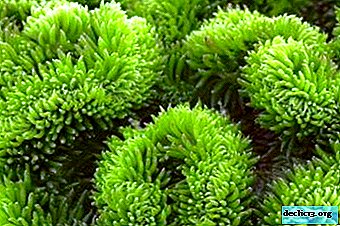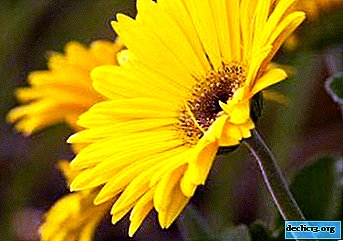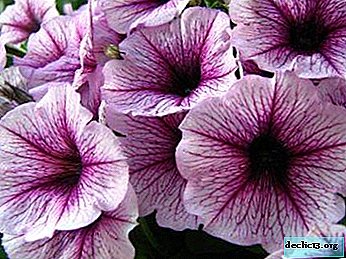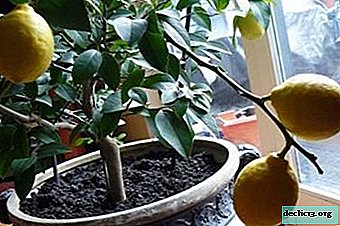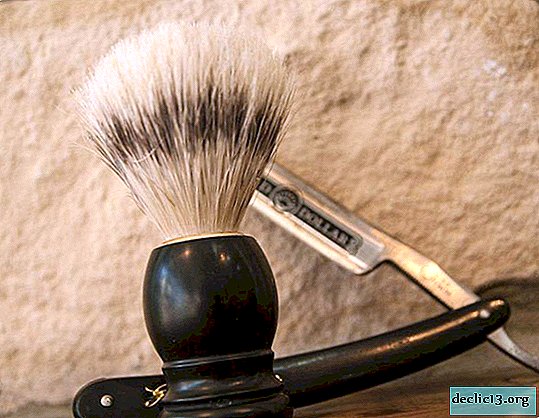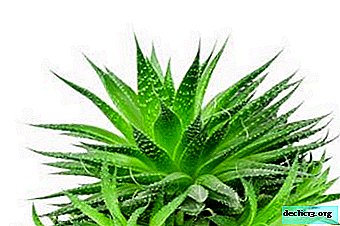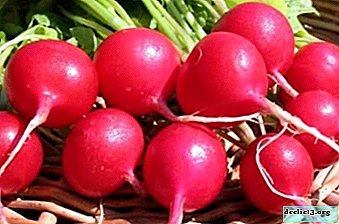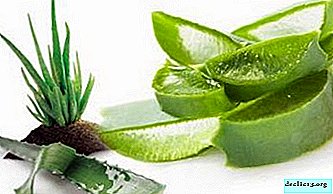Ways to deal with aphids on fruit trees
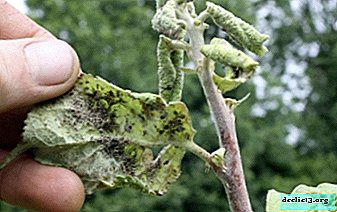
Spring is the time of awakening all life! Juice in plants begins to run with renewed vigor, the first buds and leaves appear. But along with useful flora, fauna awakens, ready to harm our plants.
Aphids do not bypass either trees or shrubs. Gardeners spend a lot of effort and money on fighting it. Prevention and destruction of this column of pests consists in a number of agrotechnical procedures.
Types of pests on garden plants
Aphids are a family of Hemoptera insects. Size from 5 to 7 mm, able to fly from place to place, some species do not have wings. With the help of wind, aphids can be carried up to a distance of 25 km. These pests breed asexually and lay eggs for the winter.Cultivated trees are affected by several species of aphids:
- Apple tree (red-gall (gray), green, bloody) - gray aphids can destroy a whole tree, if not to fight it.
Despite the name, this species can affect other fruit trees.
- Cherry - affects cherries and cherries, their eggs are resistant to frost. If you do not fight, insects impair the quality of fruiting.
- Mealy (shaggy) - likes to settle on citrus fruits, grapes. It multiplies very quickly and causes the plant to die.
- Sheet - parasitizes in the hottest period. It affects deciduous trees, attracts ants more than others.
- Greenhouse (tobacco, peach) - causes a soot fungus on plants, is an active carrier of viral diseases. If left untreated, stone fruits lose part of the crop.
What harm can it do?
 One individual aphid is not able to harm the plant, but its active ability to reproduce quickly creates numerous settlements.
One individual aphid is not able to harm the plant, but its active ability to reproduce quickly creates numerous settlements.
- Aphids live on a plant and suck out juices from it. In these places, dead sites are formed. This entails the drying of young shoots and loss of crop.
- The sweet substance (paddy) secreted by aphids can attract ants that will protect the colony from insects dangerous to them.
- A pad covers the leaves and thereby promotes the growth of the fungus on them, while the fungus inhibits the photosynthesis process.
- The pest is not only harmful to plants on its own, but also is a carrier of pathogenic bacteria.
Signs of aphid invasion:
- young shoots and buds are covered with clusters of aphids;
- most insects gather on the underside of leaves;
- the white particles in the aphid cluster are their old skin;
- leaves and buds are covered with a sticky pad;
- the affected leaves curl and dry;
- the affected buds do not develop.
Ways to Get Rid
Aphid control methods:
- Chemical using insecticides. A quick, effective and easy way, but used preparations for fruit plants can harm animals and humans.
- Biological - with the help of these means, natural aphid enemies are attracted. Eco-friendly and safe method. The result will have to wait and does not guarantee complete disposal of insects.
- Folk methods - cheap, safe, made from improvised means, little effective.
Cultivate the land
 Insecticide watering is effective in controlling aphids on land crops. To control pest in trees, spraying is more effective. However, preventive cultivation of the earth will help reduce the risk of spreading aphids:
Insecticide watering is effective in controlling aphids on land crops. To control pest in trees, spraying is more effective. However, preventive cultivation of the earth will help reduce the risk of spreading aphids:
- Digging in the fall or spring will help detect and destroy pest eggs.
- Watering the soil with an extract of ammophos.
- Watering with wood ash.
- Planting special plants that repel aphids (coriander, mint, onions, fennel, dill, yarrow, dandelion).
How to process fruit plants, as well as how to spray?
In most gardeners, spring begins with the processing of fruit trees.
- pruning unhealthy branches and removing remaining leaves;
- whitewashing trunks, wrapping the trunk with burlap or corrugated cardboard greased with solid oil (to prevent the migration of ants to the tree trunk).
Such measures are recommended in the fall, but in the spring they will be effective.
Cropped branches need to be burned, the effect of fire will not leave any chances for pests to survive.
Spraying should be done carefully, to moisten all branches and leaves profusely. The solution will not get into twisted leaves, so before the procedure, you need to remove the infected areas.
When to spray:
- branches before leaf opening;
- before flowering;
- after flowering, during the ovary;
- one month before harvesting;
- three weeks before harvesting, stop spraying the trees.
 Anti-aphid preparations:
Anti-aphid preparations:
- Neonicotinoids:
- Actara (thiamethoxam), Confidor (imidacloprid) - are intended for watering and spraying. Highly effective, expensive, do not rinse off during rain. Consumption of 4g per 5 liters of water.
- Tanrek (imidacloprid), consumption 3ml per 10l of water.
- Golden Spark (imidacloprid), consumption 5ml per 10l of water.
- Organophosphorus compounds:
- Actellic (pyrimifos-methyl);
- Karbofos;
- Anti-mite;
- Alatar;
- Fufanon.
To these drugs there is an increasing resistance.
- Pyrethroids: permethrin (Kinmix, Decis, Profi, Inta-Vir).
- Biological products:
- Fitoverm;
- Akarin.
They do not penetrate fruits and leaves, are non-toxic to bees 4 hours after processing. Processing should be carried out only at an air temperature of 18-20 ° C!
To any means, resistance develops over time, so it is recommended to change the drug for treatment every time.
Important! Wear protective clothing and a mask during spraying!Features of the fight
On the plums

- Remove all infected parts of the plant.
- To process a trunk for protection against ants.
- Treat the root zone with Fitoverm.
- Processing by means of contact action:
- Fury, Karbofos, Arrivo, Fufan. The poison is in contact with the upper shell of the insect, after which it dies.
- Copper containing preparations (Decis, Karbofos) are used again for spraying immediately after flowering.
- Systemic drugs (Actara and analogues) penetrate into the juice of the plant, insects die when fed with poisoned juice.
- Intestinal damage (Confidor, BI-58) - die immediately after the poison enters the gastrointestinal tract.
- Biological products processing: Akarin, Fitoverm.
- Processing during fruiting: the preparation "30 plus" forms a film on the surface of the cortex, under which moisture and air do not get, and insects die.
- Repeated spraying after 5 days.
- Spraying with potassium monophosphate (15 g per 10 l of water).
- Spraying with infusions of herbs (tobacco, marigolds, garlic, yarrow, tops of tomatoes and potatoes).
Folk methods recommend:
- Attraction of a ladybug (for this, calendula flowers are planted).
- Feeding the tree with potassium sulfate (3 tbsp per bucket of water), this will help reduce the reproduction of aphids.
On a lemon
 Lemons grow in a warm, humid climate, it is these conditions that aphids love and, therefore, it often affects citrus fruits.
Lemons grow in a warm, humid climate, it is these conditions that aphids love and, therefore, it often affects citrus fruits.
The most effective methods of treatment are industrial preparations:
- Fitoverm - can be used in the greenhouse and at home, treatment is carried out several times with a weekly break.
- Golden Spark - a broad-spectrum insecticide, safe for soil and plants, use indoors only with good air circulation.
- Dichlorvos - a dangerous and aggressive remedy, a home tree is placed in a bag with a napkin treated with dichlorvos) for several hours. After the procedure, rinse the leaves well with water.
If the aphid population is very large, it is necessary to mechanically remove the infected areas, cover the soil in the pot with a bag, and wash the crown with a soapy solution with a soft brush.
A few days after all the manipulations, spray the tree with "Epin", to improve its growth.
Prophylactic agents
It is best to carry out prophylaxis in the fall, then in spring less work will be waiting for you:
- Cut and burn all affected areas of trees. To process trunks and places of cuts whitewash.
- Spray the plants with hot water (70-80 ° C), repeat the procedure in the spring (until buds open). Hot water can be replaced with a solution of Nitrofen (300 g per 10 liters of water).
- Destroy the clutches of ants near the trees, for this, pour them boiling water.
- Water, fertilize trees regularly, sprinkle and mulch the soil for them.
- Regularly remove unnecessary overgrowth of trees. The soft and tender leaves of the shoots will attract the attention of aphids.
- Remove the old exfoliated bark, this will prevent wintering of pests in it.
- Viburnum and linden bushes attract aphids, so you should not plant such plants near fruit trees.
Aphids can infect any garden plant. It prevents him from growing, bearing fruit, and may even destroy him. Preventive measures can prevent the reproduction of aphids in your area. If infection could not be avoided, a variety of chemical and folk methods will come to the rescue, which can easily help you in the fight for your trees.


